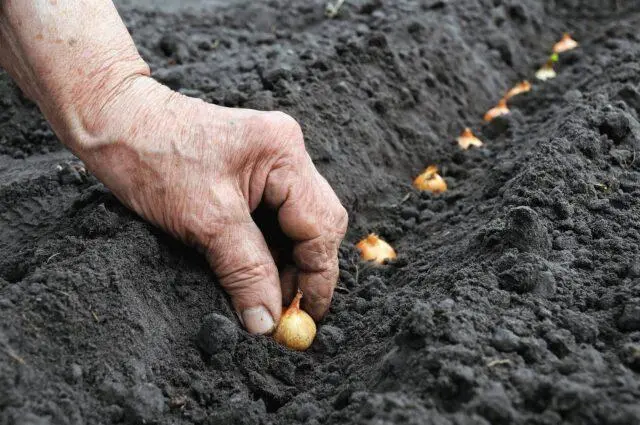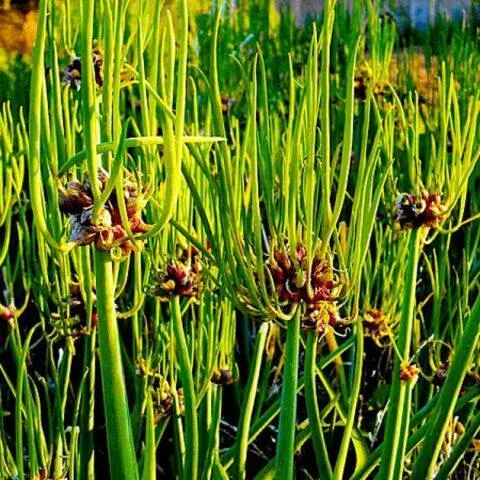Contents
Multi-tiered onion is a frost-resistant, unpretentious crop that is grown on greens and small bulbs. Used in salads and for pickling. Plants can exist for a long time in one place, require regular watering. They are resistant to most diseases and pests.
What is a tiered bow
The multi-tiered onion is a perennial crop from the Allioideae subfamily. It is a herbaceous plant that has many other names:
- horned bow;
- viviparous;
- walking;
- Egyptian;
- Canadian.
Culture comes from China – it was from there that it came to European countries and spread throughout the world. It has an unusual appearance. It is used mainly not for decorative purposes, but for food, like the usual onion varieties.
A multi-tiered bow gives peduncles-arrows from 60 cm to 1 m high. Moreover, 1, 2 or 3 arrows are formed in one season. On top are bulbous heads – bulbs, the average weight of which is 15-25 g. They grow in tiers. The name of the species is associated with this feature of the structure.
Large heads up to 3 cm in diameter appear in the lowest tier, small fruits in larger quantities form on the upper rows. The color of the bulbs is from yellow and brown to purple, depending on the variety. The root system is represented by an underground wide tuber (the form is also bulbous).
Varieties of many-tiered onions
Culture has several varieties. The most popular of them are:
- Chelyabinsk is a productive variety that produces almost 3,5 kg of greenery per square meter and up to 1 kg of the bulbs themselves. Greens contain a lot of vitamin C (70 mg per 100 g).
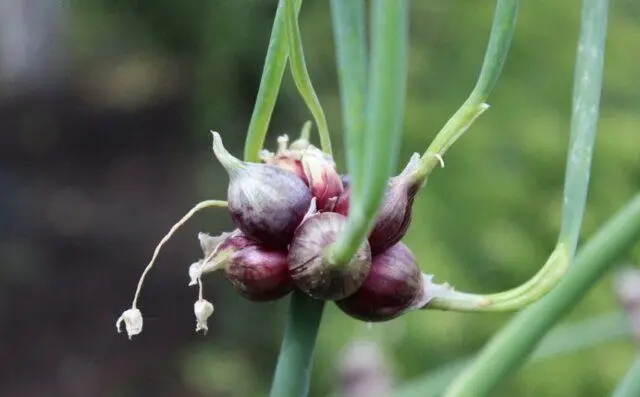
- Memory – during the season gives up to 4 kg of greenery and up to 750 g of bulbs. Taste with pleasant sweetness, spicy, crispy feathers.

- Likova – gives strong, crispy onions, they are suitable for pickling. The color is brown-red or purple. Harvest of greens – up to 4 kg per square meter.

Advantages and disadvantages
A multi-tiered onion has an interesting appearance and a pleasant taste. The plant is unpretentious, frost-resistant, so most varieties can be grown even in the Urals and Siberia.
Pros:
- can be planted in the same place;
- greens are harvested throughout the season;
- high yield;
- winter resistance to -40 degrees;
- disease resistance;
- early maturation.
Cons:
- sensitive to weeds;
- needs regular watering;
- the heads are small, more often greens are used for food.
Growing multi-tiered onions in open ground
You can grow multi-tiered onions in most regions of Our Country. The rules for landing and care are simple, but there are several features. The basic rules of agricultural technology are described below.
Terms of planting
Culture can be grown in three terms:
- Late August – early September. At this point, seeds are collected (or bought) and planted in open ground.
- Early spring – beginning, mid-March.
- It is also allowed to plant a multi-tiered bow before winter. In the middle lane, this is done at the end of October, in the southern regions – closer to the last days of November, when during the day it will be no higher than 5-7 degrees Celsius.
You can try to plan winter sowing in other regions, having prepared the mulch in advance for shelter.
Site selection and preparation of soil
The place for planting a multi-tiered bow should be:
- open (no shadow);
- dry without stagnant moisture (not a lowland);
- as far as possible protected from through winds.
The site is prepared in advance in autumn or spring. The soil is dug up and organic matter is added – compost or humus in the amount of 5-7 kg per 1 m2. If the soil is clayey, sand or sawdust 500-800 g are also covered in the same area.
Preparation of planting material
Planting material is pre-prepared. When planting bulbs, the tuber is divided into several parts. Sort by size. For long-term cultivation, the largest fragments are selected. The rest of the fractions are planted together.
Landing scheme
Planting a multi-tiered bow is simple, but it has its own secrets. They are related to the depth of seeding and the spacing between seedlings.
bulb size | Depth, cm | Interval, cm |
Large | 8 – 10 | 25 – 30 |
average | 8 | 8 – 10 |
Small | 5 | 6 |

Large bulbs are planted in furrows up to 10 cm deep.
Tiered Bow Care
Care is simple, because the culture is unpretentious. It should be noted that watering should be regular. Periodically, onions are fed, weeded and loosened. If the variety is grown as a perennial, pruning must be done for the winter. At the end of October, green feathers are removed, and if the bulb has given new shoots at that time, they are no longer touched, but simply laid on the surface and covered with mulch.
Watering
Tiered onions need watering. If there is a drought, water is given 3-4 times a week. It should be moistened until harvest, since the rhizomes are not harvested anyway (unlike onions). It is better to defend the water in advance so that it is not cold.
Additional fertilizing
Top dressing for multi-tiered onions is applied annually. In April, urea is given (40-50 g per 1 m2), in June – superphosphate (50 g) and potassium salt (45 g) for the same area. In autumn, you can repeat the same top dressing, excluding nitrogen compounds.
Weeding and loosening
When growing Egyptian onions, do not forget about weeding and loosening. Weeds take away water and nutrients, attract pests, which inevitably affects the yield. Therefore, weeding is carried out 2-3 times a month, watching for the appearance of foreign plants.
Loosening the soil must be done regularly – best of all 1-2 days after watering or rains. Thanks to this, the soil will not be compressed, and oxygen will flow to the roots. To facilitate the work, it is recommended to lay straw, sawdust or other mulch next to the plantings.
Garter
A tiered bow requires a garter, as the bulbs are heavy and the arrows begin to lean towards the ground. Therefore, next to the landings, wooden pegs or other supports are installed. The garter is made as the bulbs increase. It should be borne in mind that this procedure is optional, for example, if the crop is grown only for greens.
Pest and disease control
With proper care, a multi-tiered bow is rarely affected by disease. But sometimes a culture can suffer from peronosporosis. The fungus affects the roots, bulbs and feathers (they begin to turn yellow). For prevention and treatment, treatments are carried out with a 1% solution of Bordeaux mixture or another fungicide.
Of the pests, the onion fly is the most dangerous. She lays her eggs next to the bulbs or between the feathers. Insecticides are used to control:
- “Fitoverm”;
- “Ripcord”;
- “Diazinon”;
- “Cypermethrin”;
- “Thiamethoxam”.
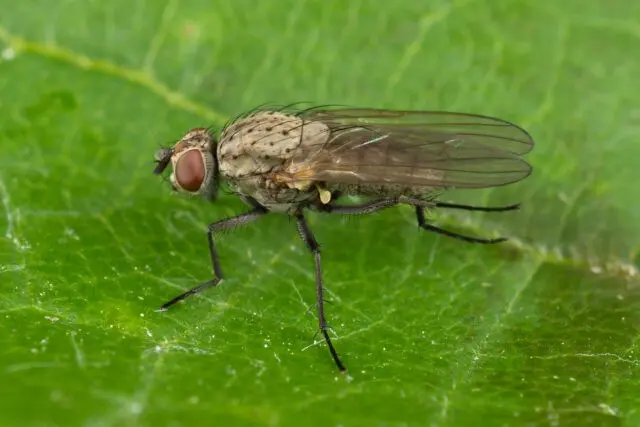
To combat the onion fly, insecticides and folk remedies are used.
In extreme cases, you can use folk remedies, for example, an infusion of chili peppers, wormwood, dandelions, a decoction of potato or tomato tops.
How multi-tiered onions propagate
Multi-tiered onions can be propagated in three ways:
- With the help of underground tubers (rhizome division).
- With the help of air bulbs.
- Seeds for seedlings
In the first case, the underground part of the plant is dug up at least three years old (this can be done at any time until the end of August), shaken off the soil and divided into several copies with a knife. Each division should have 1-2 developed roots. They are planted on fertile soil, to a depth of 10 cm, periodically watered, mulched for the winter.
Air bulbs are harvested in the second half of summer or early autumn. They are planted immediately after harvest on previously prepared soil. The depth of embedding in this case is less – 5-6 cm.
The seedling method of growing multi-tiered onions is practiced in regions with a cold spring. Seeds are collected independently or purchased in advance. In mid-March, they are pickled in potassium permanganate, deepened by 1 cm and grown under a film at room temperature. In mid-May or a little later, they are transplanted to open ground.
In the south, winter sowing of seeds is practiced. In this case, you need to plant a multi-tiered onion in the fall, as soon as the soil temperature reaches +3 ° C. Seeds are laid in grooves to a depth of 3-4 cm, covered with soil and mulched for the winter. Since not all planting material will rise, it is taken with a margin (25% more than usual).
Harvesting and storage of crops
The leaves of the multi-tiered onion are tubular, dark green in color, have a pungent taste. They are used in salad. The bulbs themselves are used to prepare marinade for home preservation. The culture is perennial, in the first year of planting, greenery is cut twice, and from the second season the procedure is carried out regularly. Up to 3,5 kg of greenery is removed from a square meter of plantings.
When growing Egyptian onions on a feather, the crop can be harvested literally 2,5 weeks after sowing. The arrows are cut almost under the base and used for food. As for the bulbs themselves, depending on the variety, they ripen by the beginning or end of August. The yield is about 1 kg per 1 m2.
Multi-tiered onion roots are stored in a refrigerator, cellar or other room at a temperature of -3 to +2 degrees, humidity 75%. In such conditions, they normally lie for three months. If stored in the vegetable drawer of the refrigerator, the shelf life is up to two months. Greens can also be cut, put in sealed bags and put in the freezer – in this form it will last all winter.
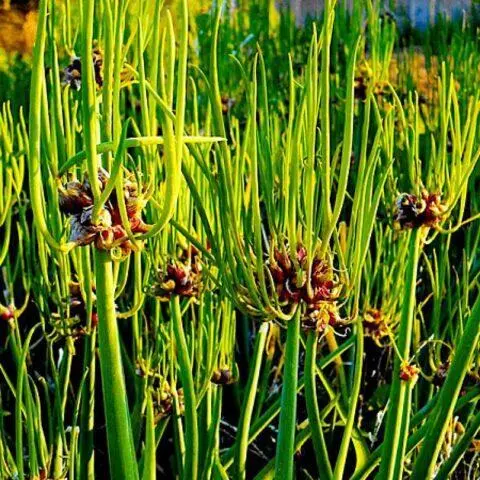
Green yield – up to 4 kg per square meter
Conclusion
Tiered onions can be grown almost anywhere. This is an interesting variety that gives a lot of greenery. If you do winter sowing, the first arrows will appear in April. In the future, they can be harvested all season until the first frost.










